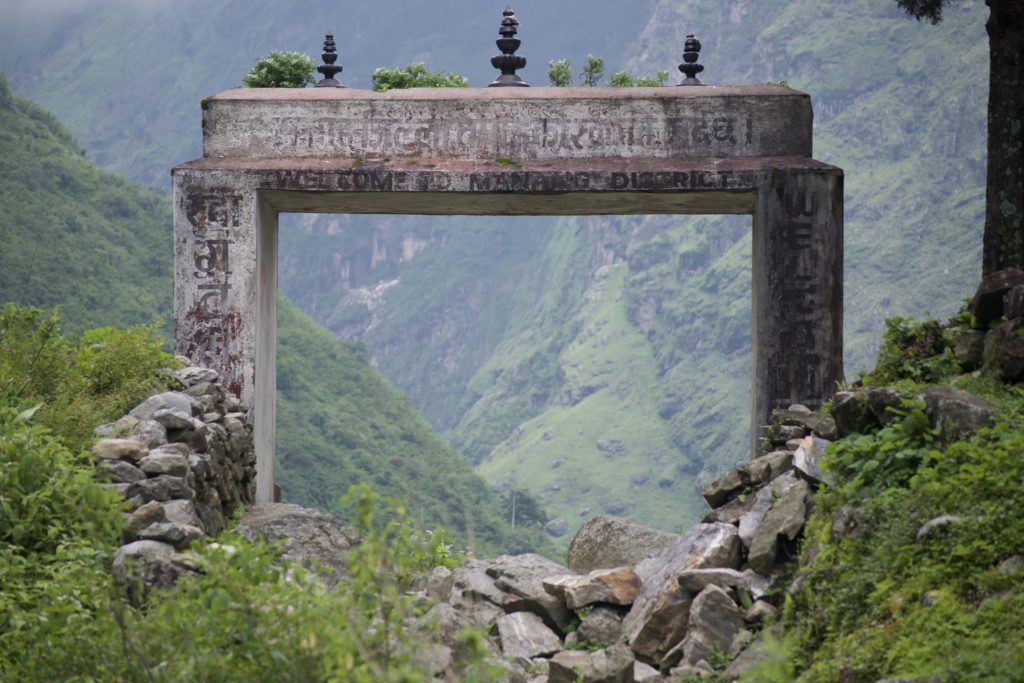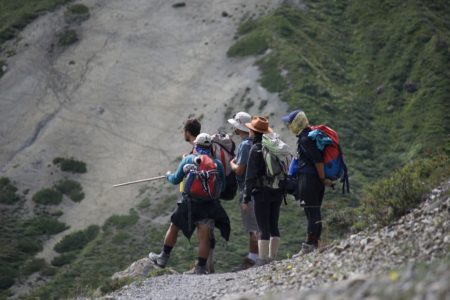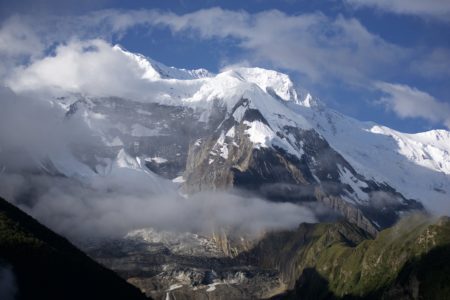Find peace on the Annapurna Circuit in the mountains of Nepal.
Story and photos by Nick Barancyk

For hundreds of years, people have searched for what remains of Shangri-La. Tibetans believe this land of peace and harmony lay high on a plateau guarded by a ring of white, crystalline mountains. The people there are immortal, storing their wisdom like grains of rice ready for times of strife. On the Nepali Annapurna Circuit, deep inside the Himalayas, it’s hard not to feel as if you’ve become an accidental seeker, another hunter of paradise.
On the trailhead
In the summer, the Nepali Himalayas are wet and green and full of flowers. The air is thick with heat and the monsoon rains uncork the waterfalls, swelling the Marshyangdi river that winds through the valley. Above, the mountains trim the sky into a zigzag strip of blue.
 One of the most incredible aspects is watching the environment evolve. At lower altitudes, the river cuts through a jungle of vines and emerald vegetation. Hiking deeper and higher, the flora calms, shrubs shorten and tree bark thickens. The waterfalls are thinner, sparser and seemingly less ambitious.
One of the most incredible aspects is watching the environment evolve. At lower altitudes, the river cuts through a jungle of vines and emerald vegetation. Hiking deeper and higher, the flora calms, shrubs shorten and tree bark thickens. The waterfalls are thinner, sparser and seemingly less ambitious.
The land continues in this fashion until the lack of atmosphere has left it barren. At 11,000 feet, only the smallest and most endeavoring foliage survives. There are no bird calls or insect clicks. Silence laces the clouds close enough to catch on your tongue. Here, above the tree line, you’re left to contemplate the mountain’s bones.
Humble beginnings
The Annapurna Circuit started as a means of trade and communication between remote Himalayan villages. Throughout time, these footpaths began linking chains of towns together, naturally forming a circuit into and out of the mountains. However, the trail is not a quick hike. It can take as long as a week to trek from the deepest towns to the roads leading to large cities and proper medical care. So, a network was constructed, one based on the inherent generosity and hospitality of the Nepali people. If you needed to leave the mountains, you’d hike from village to village along the circuit. Each town had a teahouse, a place to rest, eat or spend the night if it was late, almost like a village motel.
When the trail opened to foreigners in the 1980s, they used this network and still use it today. With the circuit’s rise in popularity, the number of teahouses and the food offered therein has changed.
 But despite the slow westernization within these villages, the people of the mountain are strong in spirit. The closer you hike to Thorong La, the effective midpoint of the trail, the culture becomes less Nepali and more Tibetan. Stupas, Buddhist commemorative monuments, sprout from mountain peaks, and tails of prayer flags and rows of Tibetan prayer wheels line the paths. The religion of this area is that of cycles and psyche and the truth in reality.
But despite the slow westernization within these villages, the people of the mountain are strong in spirit. The closer you hike to Thorong La, the effective midpoint of the trail, the culture becomes less Nepali and more Tibetan. Stupas, Buddhist commemorative monuments, sprout from mountain peaks, and tails of prayer flags and rows of Tibetan prayer wheels line the paths. The religion of this area is that of cycles and psyche and the truth in reality.
Over the pass
Traversing the 17,000-foot pass is like crossing Jupiter. The air is negligible, the scenery, extraterrestrial, and everything else, just plain heavy. But at the top, above the clouds and rock, the snowy diadem of the Annapurna mountains touch the sky. Just below the snow line, if you’re lucky, you can spot the shaggy pinpoints of yaks.
 If the hike to the pass was barren, the other side is a desert. Moisture has been squeezed from the air and lips chap instantly. The land lay bare like the crests and troughs of a dune. But there’s fragility here, a brittle and barren beauty in this place the Tibetan people call home.
If the hike to the pass was barren, the other side is a desert. Moisture has been squeezed from the air and lips chap instantly. The land lay bare like the crests and troughs of a dune. But there’s fragility here, a brittle and barren beauty in this place the Tibetan people call home.
There are pilgrimage sites in these mountains, temples that await between Tibet and Nepal. Buddhists from throughout the world travel by plane, bus, rickshaw and motorcycle to visit this unforgiving land. Maybe it’s a wisdom they’re searching for, something engraved in its boulders and particles of dust, or maybe it’s something else entirely.
The end of the line
In the morning, dew creeps from the rocks, each day staying a little longer. It starts trickling from the cliffs in rivulets, creeks and finally, skyscraper waterfalls. The vines snake back in. The jungle returns.
As far as anyone knows, Shangri-La is just a myth, an analogy symbolizing the path toward enlightenment. But being here, shielded by mountains, where people have taken a mercurial environment and thrived, is a taste of nirvana. It’s diverse and unexpected, brutal yet delicate. It’s a beautiful lesson in the reality of paradise.








